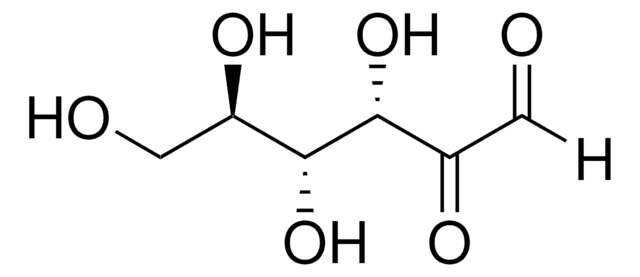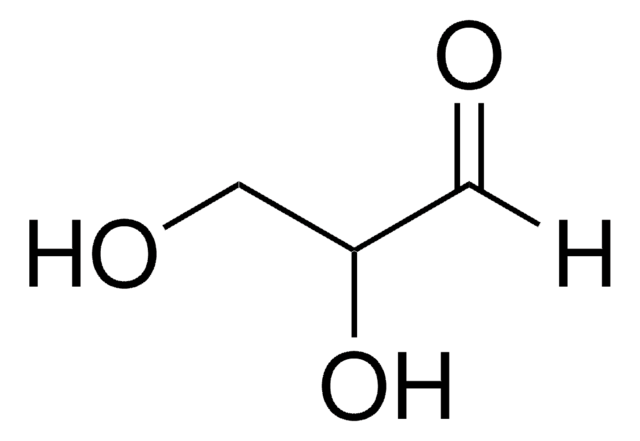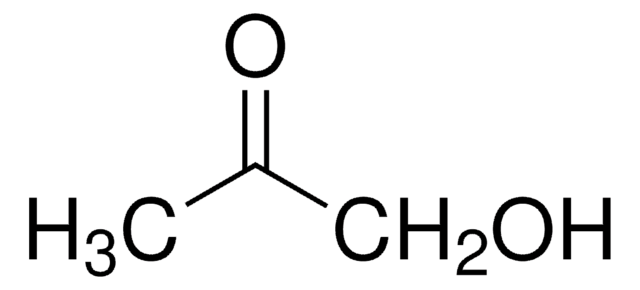모든 사진(1)
About This Item
실험식(Hill 표기법):
C6H10O5
CAS Number:
Molecular Weight:
162.14
MDL number:
UNSPSC 코드:
12352201
PubChem Substance ID:
NACRES:
NA.25
가격 및 재고 정보를 현재 이용할 수 없음
추천 제품
Quality Level
분석
≥75% (TLC)
양식
solid
색상
faintly yellow to orange
저장 온도
room temp
SMILES string
OC[C@H]1OC(O)C(=O)C[C@@H]1O
InChI
1S/C6H10O5/c7-2-5-3(8)1-4(9)6(10)11-5/h3,5-8,10H,1-2H2/t3-,5+,6?/m0/s1
InChI key
UHPMJDGOAZMIID-OPAZFOKUSA-N
애플리케이션
3-Deoxyglucosone is used as a reference for the analysis and detection of glucose degradation products, glycating agents, generated by processes such as heat sterilization.
기타 정보
To gain a comprehensive understanding of our extensive range of Monosaccharides for your research, we encourage you to visit our Carbohydrates Category page.
Storage Class Code
11 - Combustible Solids
WGK
WGK 3
Flash Point (°F)
Not applicable
Flash Point (°C)
Not applicable
개인 보호 장비
Eyeshields, Gloves, type N95 (US)
이미 열람한 고객
Danielle T Loughlin et al.
Wound repair and regeneration : official publication of the Wound Healing Society [and] the European Tissue Repair Society, 17(5), 739-749 (2009-09-23)
The interaction of fibroblasts with the extracellular matrix is critical for wound healing. Advanced glycation end products (AGEs) occur through nonenzymatic glycation of long-lived proteins such as collagens. One precursor to these modifications, 3-deoxyglucosone (3DG), is elevated in patients with
He Li et al.
Journal of agricultural and food chemistry, 67(32), 9050-9059 (2019-07-25)
The control of 2,3-dihydro-3,5-dihydroxy-6-methyl-4(H)-pyran-4-one (DDMP) formation in the Maillard reaction is important to improve the thermally treated food quality as a result of its intense bitterness and potential toxicity. In this work, phenolic acids, such as gallic, protocatechuic, caffeic, and
Alina Shapira et al.
Molecular nutrition & food research, 51(4), 473-478 (2007-03-29)
Peritoneal dialysis (PD) is commonly performed by using preprepared dialysis solutions containing glucose, which are thermally treated to achieve commercial sterilization. A series of glucose degradation products (GDPs) are being formed, which react with the tissue during the dialysis procedure
Michael Hellwig et al.
Journal of agricultural and food chemistry, 58(19), 10752-10760 (2010-09-09)
1,2-Dicarbonyl compounds are formed in food during Maillard and caramelization reactions. 3-Deoxy-D-threo-hexos-2-ulose (3-deoxygalactosone, 3-DGal) and galactosone, two 1,2-dicarbonyl compounds originating from the degradation of galactose, were synthesized and converted to the respective quinoxalines, which were characterized by NMR spectroscopy. Analytical
Caatje Y le Poole et al.
Peritoneal dialysis international : journal of the International Society for Peritoneal Dialysis, 32(1), 45-54 (2011-06-03)
Standard peritoneal dialysis (PD) solutions contain high levels of glucose and glucose degradation products (GDPs), both contributing to the formation of advanced glycation end products (AGEs). We studied the contribution to plasma GDP and AGE levels of 2 PD regimens
자사의 과학자팀은 생명 과학, 재료 과학, 화학 합성, 크로마토그래피, 분석 및 기타 많은 영역을 포함한 모든 과학 분야에 경험이 있습니다..
고객지원팀으로 연락바랍니다.






